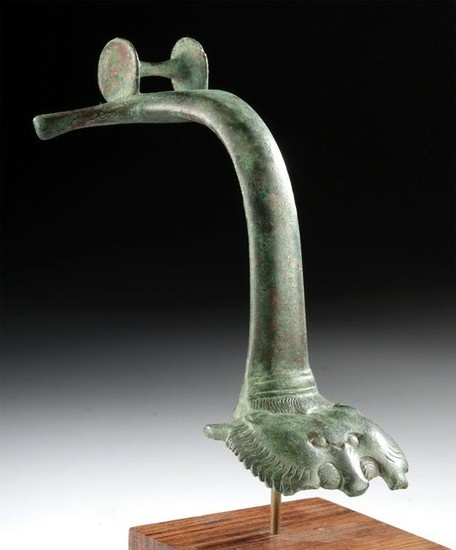Published Greek Bronze Handle w/ Lion, ex-Christie's
Greece, Classical Period, ca. 480 to 450 BCE. A handsome cast bronze handle from an oinochoe terminating in a skillfully rendered lion head at the lower end - wild feline's visage presented in frontal view with perky rounded ears, almond-shaped eyes, a pronounced snout, and a thick, wavy, radiating mane. The upper end presents a spool-shaped thumbrest. Lions are often the stars of ancient Greek stories, such as the Nemean lion, and it is probable that the sculptor of this piece saw lions in real life: Aristotle and Herodotus tell us that lions lived in the Balkans and Greece until around the 1st century BCE! Size: 4.375" H (11.1 cm); 5.75" H (14.6 cm) on included custom stand.
In the classical world, lions symbolized power, wealth, and might. They were famously featured in many ancient myths, perhaps the most famous being that of Hercules (Greek Herakles) slaying the Nemean lion for his first labor. That lion's fur was believed to be impenetrable to attacks since according to legend it was made of gold and its claws were far sharper than swords with the power to slice through armor. In the end, Hercules defeated the lion by strangling it and wore its skin.
Lions were also favorite iconography for buildings, coins, and statues in the ancient world. Examples include the Lion Gate to the Citadel of Mycenae, the Terrace of the Lions on the island of Delos, and the lion hunt mosaic from Pella featuring Alexander engaged in a lion hunt.
Published in A.P. Kozloff, ed., "Animals in Ancient Art from the Leo Mildenberg Collection," Cleveland, 1981, nos. 113 and 115.
Provenance: private East Coast, USA collection; ex-Bonhams, London, Knightsbridge Antiquities auction (September 30, 2014, lot 377); ex-Christie's, New York Antiquities auction (sale 2605, December 5, 2012, lot 23); ex-private Midwestern American collection; ex-Christie's, London "A Peaceable Kingdom: The Leo Mildenberg Collection" auction (sale 7017, October 26-27, 2004, lot 305); ex-Leo Mildenberg collection, acquired prior to 1981
All items legal to buy/sell under U.S. Statute covering cultural patrimony Code 2600, CHAPTER 14, and are guaranteed to be as described or your money back.
A Certificate of Authenticity will accompany all winning bids.
We ship worldwide to most countries and handle all shipping in-house for your convenience.
#147834
Condition Report: Minute loss to right front side of bear's face and upper left terminal. Otherwise excellent with well-preserved details and gorgeous green patina.
View it on
Sale price
Estimate
Time, Location
Auction House
Greece, Classical Period, ca. 480 to 450 BCE. A handsome cast bronze handle from an oinochoe terminating in a skillfully rendered lion head at the lower end - wild feline's visage presented in frontal view with perky rounded ears, almond-shaped eyes, a pronounced snout, and a thick, wavy, radiating mane. The upper end presents a spool-shaped thumbrest. Lions are often the stars of ancient Greek stories, such as the Nemean lion, and it is probable that the sculptor of this piece saw lions in real life: Aristotle and Herodotus tell us that lions lived in the Balkans and Greece until around the 1st century BCE! Size: 4.375" H (11.1 cm); 5.75" H (14.6 cm) on included custom stand.
In the classical world, lions symbolized power, wealth, and might. They were famously featured in many ancient myths, perhaps the most famous being that of Hercules (Greek Herakles) slaying the Nemean lion for his first labor. That lion's fur was believed to be impenetrable to attacks since according to legend it was made of gold and its claws were far sharper than swords with the power to slice through armor. In the end, Hercules defeated the lion by strangling it and wore its skin.
Lions were also favorite iconography for buildings, coins, and statues in the ancient world. Examples include the Lion Gate to the Citadel of Mycenae, the Terrace of the Lions on the island of Delos, and the lion hunt mosaic from Pella featuring Alexander engaged in a lion hunt.
Published in A.P. Kozloff, ed., "Animals in Ancient Art from the Leo Mildenberg Collection," Cleveland, 1981, nos. 113 and 115.
Provenance: private East Coast, USA collection; ex-Bonhams, London, Knightsbridge Antiquities auction (September 30, 2014, lot 377); ex-Christie's, New York Antiquities auction (sale 2605, December 5, 2012, lot 23); ex-private Midwestern American collection; ex-Christie's, London "A Peaceable Kingdom: The Leo Mildenberg Collection" auction (sale 7017, October 26-27, 2004, lot 305); ex-Leo Mildenberg collection, acquired prior to 1981
All items legal to buy/sell under U.S. Statute covering cultural patrimony Code 2600, CHAPTER 14, and are guaranteed to be as described or your money back.
A Certificate of Authenticity will accompany all winning bids.
We ship worldwide to most countries and handle all shipping in-house for your convenience.
#147834
Condition Report: Minute loss to right front side of bear's face and upper left terminal. Otherwise excellent with well-preserved details and gorgeous green patina.



